|
fashion: feature
 Under cover
Under cover
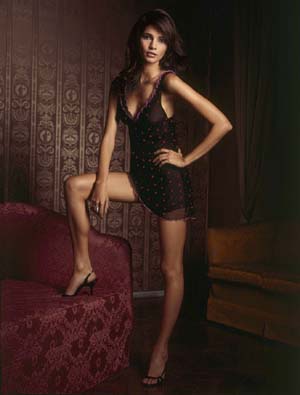
Sylvia Giles examines the story
of lingerie, and its link to recent history
Expanded from issue
22 of Lucire
THERE’S UNDERWEAR,
and there’s lingerie. Men are left only to ponder, ‘Boxers
or briefs?’ while the female body is sculpted and adorned in a way
of its own. A friend of mine differentiates her ‘practicals’, from
her ‘number ones’, the far superior, frequently lacy variety of
undergarment (of which she has numerous pairs.)
What determines the female ideal is influenced
by a number of elements, not to mention a different approach from
men and women. A collective female cry can be heard on Friday or
Saturday night from women the world over swearing they look hot
only to be shot down by tactless boyfriends. This “ideal”,
tucked away in our society’s subconscious, means that when we come
to buy lingerie, we are considering factors that are decorative,
utilitarian, political and social, all the time wanting something
we like and still holding out to knock someone flat. As a
result, lingerie can be used as a barometer to our ideas surrounding
the female ideal, a snapshot in time of what it means to be a woman.
It is then no surprise that as women’s roles have undergone revolution
in the last century, so has our underwear drawer.
A century ago, after hundreds of years of dominance, the corset
was still the standard undergarment, casting a patriarchal shadow
over women’s silhouettes. Culturally, it has become a symbol for
ill health, male dominance, and the immobilization of women into
pretty objects to be seen and not heard. In the early 1900s, the
Edwardian era saw the corset reach such extremes so that it was
being extended all the way down to the knee. However, it was to
entirely disappear within one short decade, never to be seen again,
as women shifted away from their traditional roles and their undergarments
changed as a result.
The catalyst for such a dramatic shift in undergarments
can be traced first to the appearance of women in the workforce
during World War I. This created a much more utilitarian approach
to underwear, reflecting women’s increasingly active roles. Following
the long and brutal war, 1920s Europe entered a new phase of frivolity.
Women’s realization that they could play more active roles in society
was combined with sexual revolution that continued to the evolution
of underwear, warding away any possible return of the corset. It
is at this point we see the first signs of modern lingerie. In an
ironic prelude to the bra-burning sexual revolution of the ’60s
and ’70s, the introduction of this iconic undergarment was hailed
as a move towards women’s liberation, flattening the bust and endowing
young women with a playful boyishness. However, this progress was unable
to be sustained with the intervention of the Depression in the 1930s.
Hard times foster conservatism, and so women in the 1930s returned
to the curvy silhouette of eras past, with lingerie returning the
emphasis to hips and bust. The ’40s once again forced a utilitarian
approach to underwear as men, once again, went off to war, and women
returned to the workforce. A woman’s choice of underwear was again
determined by necessity, rather than the luxury of æsthetic. By the 1950s, a traumatized generation of men had seen two
World Wars in less than 30 years. While their reaction to World
War I may have been to celebrate with a decade-long party, the 1950s
set out to create the illusion of sublime domesticity, the affirmation
of family with a mother, father and children. It is no surprise
that in this climate, once again our “ideal female” returns
to a voluptuous from. At this stage, technology also impacts on
the face of lingerie. Our grandmothers would have been thrilled
with the invention of elastine, which easily transformed the female
body without the use of materials such as bone wood and metal. It
is arguable here that, without it, the corset could have very well
resurfaced.
However, despite the supremacy of domesticity,
women were not to forget their independence gained from the war.
Bra manufacturer Maidenform ran a series of ads for years with women
realizing their dreams in their undergarments, for example: ‘I won
the election in my Maidenform
bra.’ Though the empowerment of women through lingerie had no immediate
effect on the “housewife ideal” promoted by contemporaneous
society, it was an undercurrent that swept into the youth movement
of the ’60s. Nineteen sixty-one saw the introduction of the pill,
the first reliable contraceptive available to women, forever
equalizing the gender equation in sexual affairs. Parallels between
these changes and the sexual revolution earlier in the 1920s can
be drawn namely the reoccurrence of the androgynous silhouette and
a sexually liberated youth movement.
And perhaps it was the invention of the pill,
heralded as the most socially significant advance of the century,
which allowed the sexual revolution of the ’60s to flourish where
that of the ’20s had floundered. In the 1970s, not all women burned
their bra, and the mood of this was reflected in freer, more natural
underwear. In the ’80s, when a woman’s right to be in the workplace
was cemented, power suits created an illusion of masculinity in
a world where women were now securing careers, not just employment.
Interestingly, lingerie trends polarized from this, becoming increasingly
girly and frilly, a reactionary statement to having to conform to
a masculine ideal in order to achieve success.
And away from the workplace, the trend was even
more extreme. Who could forget Madonna’s ‘lingerie as outerwear’
æsthetic? Perhaps in light of the culture of excess the 1980s
is renowned for, women’s newfound careers and the resulting disposable
income played a part. Thus, it could be argued that the 1980s saw
a portrayal of women’s idea of the feminine ideal, as opposed to
what males might like to see.
The ’80s trend of sculpting the body to within an inch of
its life in order to achieve an idealized perfection was an indication
of what was to come. Scientific progress allowed women to make choices
about how we embellish their bodies, and plastic surgery offered
us the ability to tamper with it from under the skin as well. Note
the curious inclusion of erect nipples in shop mannequins recently:
it’s interesting to wonder where it is has any relation to the current
climate of hyper-sexual identity in our society, or whether we have
reacted in sexual identity to the ability to achieve physical perfection.
Underwear has indeed responded: the Wonderbra
had actually been around for 30 years but when it was relaunched
in 1994, it struggled to keep up with demand.
SO AFTER THE PLEASURE of perusing
through a century of lingerie and considering its role in portraying
women’s sexuality, I couldn’t help but relate it back to my recent
experience. As a male friend pointed out recently, with my first
pay cheque after four years of student hardship, it was hardly sensible
of me to go out and buy beautiful expensive designer lingerie before
prioritizing such practical necessities as my groceries for that
week, a diary for the coming year, and the need to replace my slowly
dying cellphone. As it were, with no significant other in the picture,
there was going to be no second party admiring this extravagance.
It was pure self-indulgence. Lingerie, for me, represented the reclaiming of my feminine identity for myself
as opposed to packaged up for someone else. And perhaps keeping
that identity close to my chest, so to speak. In this one scenario
I had encountered all the elements that influence us as women when
buying lingerie. How I see myself in relation to the female ideal,
how men are to view me, all with a little regard to such practical
matters and fit and practicality thrown in for good measure.
Granted, women can often be guilty for attaching
significance to all the wrong things. It was a lot of thought put
into buying what is fundamentally some material, elastic, under
wire and some (albeit divine) lace. But we are women, and we like
these things. For men, take note, it is similar to good sound production
values on your favourite films. You may not be aware this kind of
maintenance is taking place in the background, but you will notice
if it’s done badly. This season’s offerings follow outerwear’s fashion trends.
With so much fear in the world, the response has been to head back
along the continuum towards the more conservative. The colour palette
is muted and traditional with pastels, in a dusty pink or mint green,
with perhaps a chocolate brown as an accent. Detailing has been
kept quiet, but exquisite. There has been a return to frilly knickers,
and the G-string has returned to being subdued after an obnoxious
outburst, out from under the waistbands of young women everywhere.
When considering the cut of your lingerie, it is coming down to
choosing the most flattering that will deliver on fit while being
occasion appropriate.
Choosing lingerie is a serious business and for
those that might be a little intimidated by the choice, The
Lingerie Handbook, by Rebecca Apsan will be your godsend.
It is written with the greatest enthusiasm—she describes G-strings
as ‘artfully placed nothing’. Apsan has a solution for everything.
Have you heard of Nippets? Nipple covers that protect your extremities
from the elements in a sheer or tight fitting top. She leaves no
stone unturned, from the adolescent female in her first training
bra, to maternity underwear, from breasts that are either too small
or too large to fit within most sizing systems to silhouette repressing
elastomeric wear. For any top, dress, situation, problem, there
is an answer here in this book. It is an “everything you ever
wanted to know about lingerie but were too afraid to ask–couldn’t
find a shop assistant–felt lost with the amount of choice”
kind of a book.
So the “panties’ pendulum” is clear, with its
cyclical swing from conservatism to liberalization and back (and
forth) again, with its resulting formation over our bodies. Lingerie
is pertinent portrayal of not only fashion trends, but of elements
of gender and the sociopolitical. Lingerie isn’t only an indicator
of the perception of the female ideal, but actually maps for us
how gender itself undergoes fluctuation, revision and sometimes
even revolution. •
Add
to Del.icio.us | Digg
it | Add
to Facebook
|
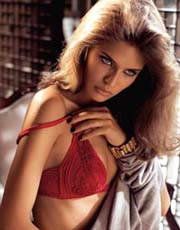
Left: Triumph
Hearty Temptation chemise, available at Figleaves.
Above: La Perla Collezione
Smart Set, available online in some countries, and at IM
Boutique in Australia and New Zealand.

Above: The Eden set from Barbara
of France (yes, we know this makes it Barbara Eden).
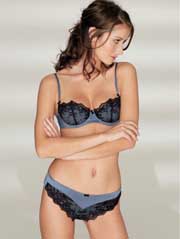
Above: Two tones remain fashionable at Elle
Macpherson Intimates. The Belle collection launched in June
2007 Down Under featuring tiny bow ties.

Above: Victoria’s Secret’s brand has put the company
into the consideration sets of many people. Here, the Secret Embrace
push-up bra.
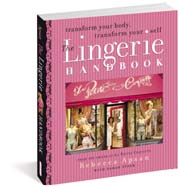
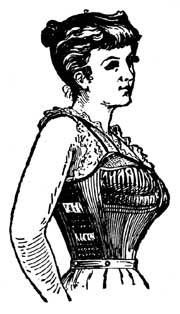
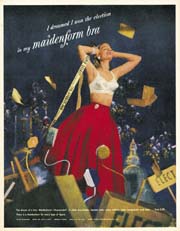
Above: Rebecca Apsan’s The
Lingerie Handbook puts lingerie in its context, including
tracing its changes through history. Below: Wonderbra’s
1990s campaigns celebrated the voluptuous figure once again, beginning
with a 1994 relaunch.
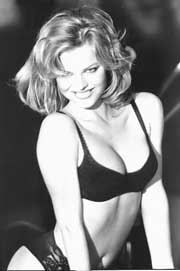
|

